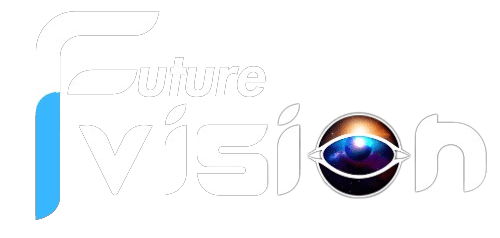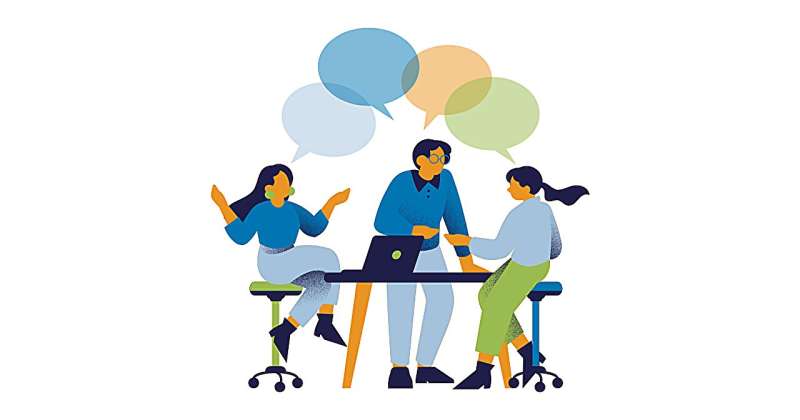Managers at every company—especially big corporations—face a similar conundrum: What’s the ideal way to organize employees to generate the best ideas? Is it better to work in large groups? Smaller ones? With other people who are similar or different?
New research from Binghamton University, State University of New York offers insight into these questions—and some of the results are not what you’d expect.
For nearly 20 years, Professor Shelley D. Dionne—now dean of Binghamton’s School of Management—and Distinguished Professor Hiroki Sayama have studied complex group dynamics and how they affect organizational performance. In a published paper in the journal npj Complexity, they look at how various clusters of people tackle creative tasks.
The experiments—conducted from 2018 to 2020—involved 617 Binghamton University students who collaborated anonymously using a Twitter-like online interface on one of two tasks: Develop a catchy marketing slogan for a new laptop computer or write a fictional story. As part of groups with 20 to 25 people, they would log in daily for 10 working days for about 15 minutes each day to submit ideas and comment on or like their collaborators’ ideas.
Language analysis of self-introduction essays submitted before the experiments determined whether students shared similar views or backgrounds when grouping them together. Some participants could communicate with their entire group, while others were able to communicate only with their “neighbors” on a ring-shaped organizational chart.
To judge the quality of ideas, the research team recruited Ph.D. candidates majoring in marketing or management for the slogan task, and staff members in the University’s Division of Communications and Marketing for the story-writing task.
Researchers admit that several of the conclusions from the study seem counterintuitive.
“If you connect all the participants in the social networks so that everybody can see everybody else’s ideas in the timeline, the experiment clearly showed that it killed idea diversity,” said Sayama, a faculty member at the Thomas J. Watson College of Engineering and Applied Science’s School of Systems Science and Industrial Engineering.
Communicating with more people, however, did make people happier. Those who interacted with fewer other participants caused them to feel more isolated but also produced better ideas.
Also, when they put together people of diverse backgrounds, the ideas became more conservative because everyone vetted it from their areas of expertise and steered the group toward “safer” alternatives.
“When we just randomly connected people together, that turned out to be the most likely to produce the best ideas,” Sayama said.
He sees the process of generating ideas as similar to evolution, with ideas as organisms that either adapt and thrive in a biodiverse ecosystem or are eliminated when they don’t survive the wrath of predators and their environment.
“When two people are talking to each other, you are one island and I am another island. There is a channel that connects the two islands, and the ideas we are exchanging are like birds or fish or insects moving back and forth,” he said.
“Each brain contains thousands of different idea ‘organisms,’ and they escape from one island and get into another Island’s brain. If they are liked by that environment, the idea will start replicating in your brain. If that idea is hated by the environment, it’s going to be killed. If you consider it that way, the whole process is about promoting biodiversity.”
Sayama admitted that implementing similar experiments in a typical office environment would be difficult. Researchers used artificial intelligence to analyze participants’ backgrounds and text inputs. But managers can pare it down to a simple question: What is the objective? If they want to promote a “biodiversity” of ideas, that requires a different strategy than keeping one precious “species” (idea) alive.
Dionne believes the strength of the study is the intersection of different disciplines in exploring creative task processes within networks.
“Relating idea generation to evolutionary processes enabled the research team to use a common framework when deciding how to test assumptions, but the common framework was merely a starting point,” she said.
“Without each team member bringing their unique expertise to the investigation, we may not have been able to drill down into understanding collaborative actions in social network structures.”
Sayama added, “There are lots of different messages that each person who reads this paper can take from the findings. This is definitely not the conclusive end of the project—it only opens up many other directions that we hope we can pursue.”
The experiments for this research happened before COVID-19 and in the first few months of the pandemic, but the team became busy with the University’s public health-related decision-making tasks and the project went on hiatus.
“We had the experimental data but no mental or physical resources to analyze our findings and put them together into a paper during the pandemic,” Sayama said. “But finally, it’s coming out.”
Even while the project was on hiatus, Dionne remembers being awestruck by what the team was achieving, “When I look back to 2018, ‘artificial intelligence’ honestly was not being widely discussed in management literature, let alone employed as an analytic tool. I knew once we could be together again that we had a unique opportunity to push the field forward.”
Also contributing to the research are Yiding Cao, MA ’16, Ph.D. ’23; Yingjun Dong, MA ’16, Ph.D. ’22; Minjun Kim, Ph.D. ’24; Neil G. MacLaren, MBA ’18, Ph.D. ’21; Sriniwas Pandey, Ph.D. ’23; and Distinguished Professor Emeritus Francis J. Yammarino.
More information:
Yiding Cao et al, Effects of network connectivity and functional diversity distribution on human collective ideation, npj Complexity (2025). DOI: 10.1038/s44260-024-00025-9
Provided by
Binghamton University
Citation:
What’s the best way to organize people to generate ideas? New research offers insight (2025, February 4)
retrieved 4 February 2025
from https://phys.org/news/2025-02-people-generate-ideas-insight.html
This document is subject to copyright. Apart from any fair dealing for the purpose of private study or research, no
part may be reproduced without the written permission. The content is provided for information purposes only.

